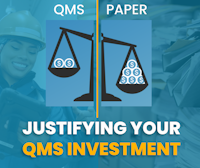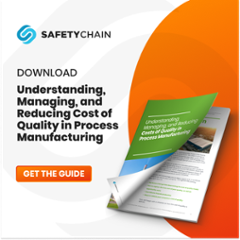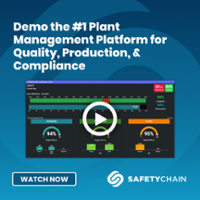5 Ways to Justify a QMS System Investment
The QMS Return On Investment
When evaluating the potential payoff of a QMS investment, companies can assess their potential return on investment using this simple ROI calculation:
(Gain/Savings Achieved from the Investment – Cost of Investment) / (Cost of Investment)
SafetyChain sat down with Norima Consulting, an innovation accelerator that transforms businesses through the use of the right technology to improve bottom line results, to discuss 5 ways a QMS investment can benefit food, beverage, and CPG companies.
Oftentimes, companies seek to invest in quality management software (QMS) when they’re struggling to gain visibility across disparate systems, facing compliance or quality challenges, or discovering the inefficiencies of paper-based systems. While a QMS system can certainly address these problems, it can also drive a number of other benefits throughout any plant.
1. Quality Management Systems Reduce Operational Cost
QMS systems reduce operational costs in several ways: automating processes; eliminating the costs associated with paper; and improving outcomes across rework, waste, and downtime.
Process automation eliminates manual tasks, thereby increasing efficiency and productivity. It also improves your plant’s ability to stay within specifications and reduces the risk of human error which would otherwise exist with manual data entry. This in turn increases data integrity, and also frees up time to reassign people to more value-added activities. For instance, an associate who once spent a good portion of their time filing or chasing down paperwork might now be able to perform trend analyses.
Additionally, process automation allows for the standardization of reporting and metrics. Document management with version control helps to ensure the correct SOP is tied to the appropriate document at all times, thereby minimizing the risk of errors.
Plus, with better data integrity and visibility into variability, a QMS investment helps plant managers make better operating decisions which also helps to reduce downtime.
The Hidden Cost of Paper
Of course, eliminating paper-based systems results in savings in itself. Many leaders in manufacturing are surprised to discover just how much the costs of paper can add up. Here’s a quick breakdown taken from The Real Cost of Paper: Facts That Show What Your Business Spends (and Where It Can Save) of the cost of paper and what you could save by investing in a QMS system:
$1,550 – the total cost of use for one $50 box of paper
$2,000 – the annual cost to maintain one four-drawer filing cabinet
$20 – the cost to file a document (including labor, storage, and office supplies)
$120 – the cost of finding a missing or misfiled document
$220 – the cost to reproduce a missing document
Being that many facilities have entire rooms dedicated to filing systems, one can only imagine the vast amount of money being spent on physical copies of records each year. If you have a rough idea of the number of records you generate daily, weekly, or monthly, however, you may be able to plug in the numbers and reveal some illuminating results.
Calculating Rework, Waste, and Downtime Savings
To further identify how a QMS system could help lower your operational costs, consider how it can help you save across three key areas: downtime, rework, and waste. Here are some quick calculations to use:
Downtime: $/minute X minutes down
Rework: cost of materials, labor, overhead associated with production losses, and packaging, all added up
Waste: cost per unit X number of units scrapped
For example, one protein powder company knew they produced an average of 6,000 lbs. of wasted product each day. Based on the following calculation, reducing waste by 50% with the help of a QMS system could yield more than $1.6 million in annual savings:
6,000 lbs. @ $2.10/lb = $12,600
Potential daily cost savings: $6,300/day
x 261 working days in a year = $1,644,300
The waste volume of 6,000 pounds only represents 2.5% of the company’s total production, and therefore didn’t seem like a major area for concern. Yet, upon discovering the potential cost savings of $1.6 million per year, reducing waste certainly became a worthwhile goal.
2. Quality Management Systems Increase Productivity
QMS systems put valuable information at the fingertips of your operators, supervisors, and C-suite. These solutions drive productivity across the entire plant by:
Displaying real-time data. All information entered by operators can be collected from the plant floor immediately, and calculations can be performed on the back-end for complete visibility into current production status and dynamic decision-making.
Integrating the supply chain. The software can bring together legacy systems for one cohesive solution, eliminating duplicate content and data entry. Information from equipment sensors can be automatically integrated directly into the QMS, which also ensures traceback capability by assigning the proper data to the correct batch record.
Automating alerts and notifications. Users are notified of non-compliances as soon as they happen, enabling a proactive — instead of reactive — approach. Supervisors can see a current state of the floor’s production activities, while the C-suite can view data on dynamic dashboards. These real-time insights are invaluable for compliance and quality checks. Simple adjustments such as altering line speeds could drastically reduce quality issues and other problems, providing added control and empowering all employees to act quickly and ensure all specifications are being met consistently.
3. Quality Management Systems Increase Profitability
Norima Consulting points out that profitability is a natural byproduct of the aforementioned improvements gained through a QMS system. For instance:
When you reduce operational costs, you increase overall profitability.
With a higher quality of products, you can drive sale prices or attract new customers.
Increased throughput leads to more product that can be sold. It also results in more consistent, reliable products that are shipped out on time, which also promotes customer satisfaction.
Whether you’re in CPG, food, or another type of manufacturing, these benefits all lead to increased profitability.
4. Quality Management Systems Streamline Compliance
Compliance is a continual challenge for manufacturing facilities. In food and beverage, for instance, there are not only rigorous regulatory requirements that must be satisfied but also voluntary programs such as GFSI, as well as customer requirements. Fortunately, there are several ways in which a QMS system can enhance compliance efforts. Read more about best practices for food quality assurance.
When documents are stored in the Cloud, rather than on paper, the possibility of lost records is virtually eliminated. Operators simply enter data on the plant floor using tablets, mobile phones, or another digital entry system. There are no longer any physical papers to worry about, and the threat of missing papers is altogether diminished. Operators also have all the data they need to access right at their fingertips. The hassle of lost SOPs – a common complaint among many manufacturing lines – is gone, as these critical documents can be made easily accessible from tablets or other mobile devices.
QMS systems also ensure that your reports are audit-ready. Unannounced audits become far easier to navigate when you don’t have to sort through filing cabinets or binders. Information is complete and up-to-date. QMS systems allow you to set up controls to ensure fields are never left blank. Plus, there’s no longer a need to decipher any hard-to-read handwriting. With these benefits, you’ll be better able to ensure your processes are meeting requirements for all of your programs, whether that’s FSMA, HACCP, or another safety, quality, or customer program.
5. Quality Management Systems Enhance Customer Satisfaction
As one of the biggest revenue drivers, customer satisfaction is critically important to any manufacturer. Without positive reviews, recommendations by word of mouth, and renewed contracts, you simply can’t continue to stay competitive in your industry.
QMS systems support customer satisfaction by ensuring that the look, feel, taste, texture, or any other key qualities of your products remain consistent. With reduced rework and compliance issues, you’ll also be better able to send on-time shipments. This will increase profit margins, and potentially expand your customer base.
Identifying all the ways in which you could save is a practical way to determine whether a QMS system investment is right for your company. In fact, even if you’re already certain it’s time to leverage a QMS solution, adding up the potential savings is a wise choice, as it will frame your goals for the post-implementation period. The better you’re able to measure the areas of operational costs, productivity, profitability, compliance, and customer satisfaction, the better you’ll be able to manage them.
About the Author
Tracy Gromniski was a Senior Business Analyst with Norima Consulting when she conducted this interview, and now is the CEO of Strive Business Solutions. During her time with Norima, her focus was on the agriculture and Agri-food sectors, where she led digital transformation, integrations, and custom-built solution implementations. A farm girl born and raised in Southern Manitoba, Tracy comes equipped with 20+ years of Ag, Food Manufacturing and Business experience, plus a full Business Analyst toolbox. With her unique skill set and years of experience leading projects for large enterprises across North America, she ensures that her clients receive the right solution to any problem. Her enthusiasm for problem solving and leadership goes beyond work, where she is the devoted mother and a dedicated volunteer on multiple committees.




